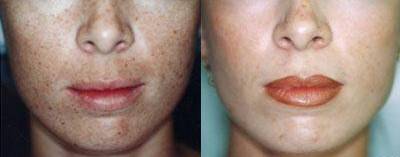
Chemical peel uses a chemical solution to improve and smooth the texture of the facial skin by removing its damaged outer layers. Procedure comprises of application of the chemical solution to the affected area, most often over the entire face. The chemical agents then act to separate and "peel" the outer surface layers of the skin. These layers often contain dead skin which is removed during the process. The chemical agents serve to stimulate the generation of new skin cells through the healing process. During the application, patients may experience a cool, warm, or hot sensation that can last for ten minutes or more.
Superficial peels such as alphahydroxy acids - glycolic, lactic, or fruit acids are the mildest of the peel formulas and produce light peels. These types of peels can provide smoother, brighter-looking skin. These peels may be used to treat fine wrinkling, patchy pigmentation and acne. Various concentrations of an AHA may be applied weekly or at longer intervals to obtain the best result.
Medium-depth peels such as trichloroacetic acid (TCA) can be used in many concentrations. Fine surface wrinkles, superficial blemishes and pigment problems are commonly treated with TCA.
Deep peels such as phenol is the strongest of the chemical solutions and produces a deep peel. It is used mainly to treat patients with coarse facial wrinkles, areas of blotchy or damaged skin caused by sun exposure.
All kinds of peels require post-procedure strict photo-protection and use of sunscreens.